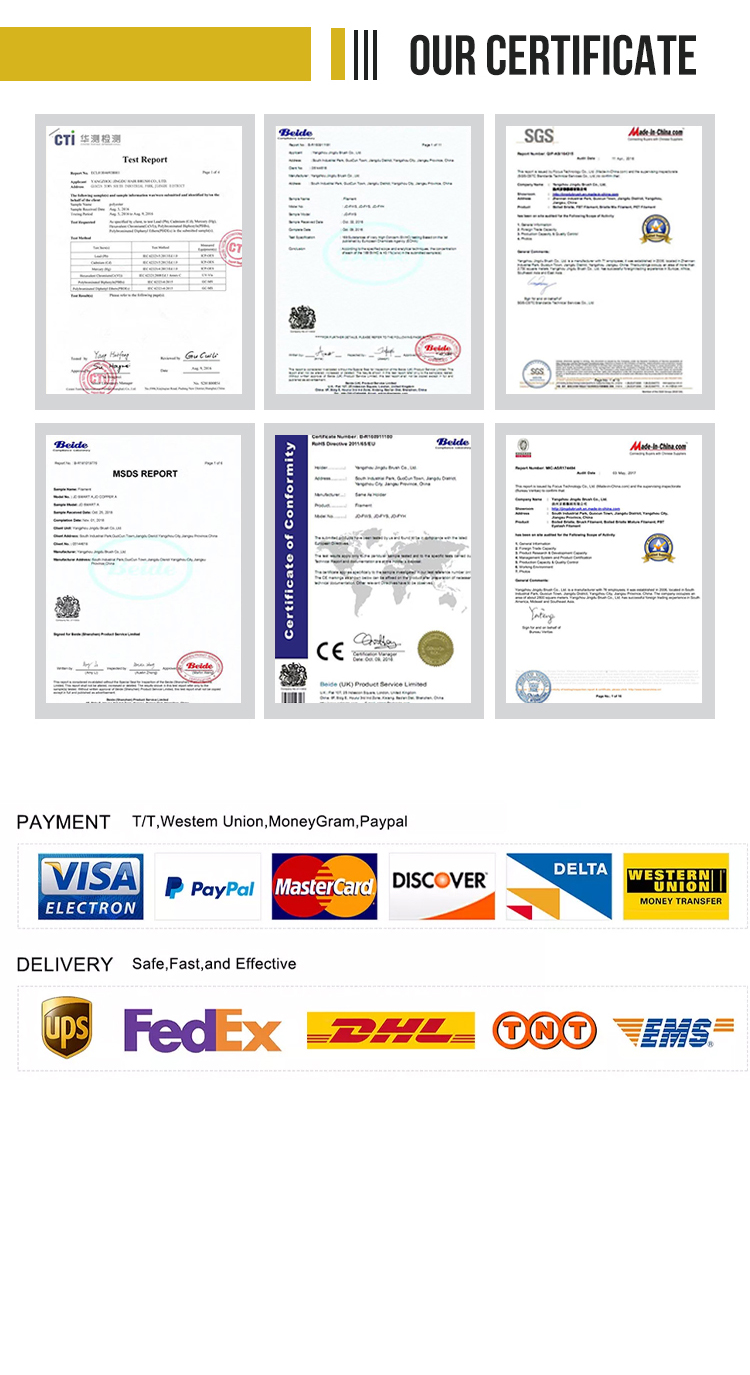Release time:2023-11-24 16:05:10 browse:
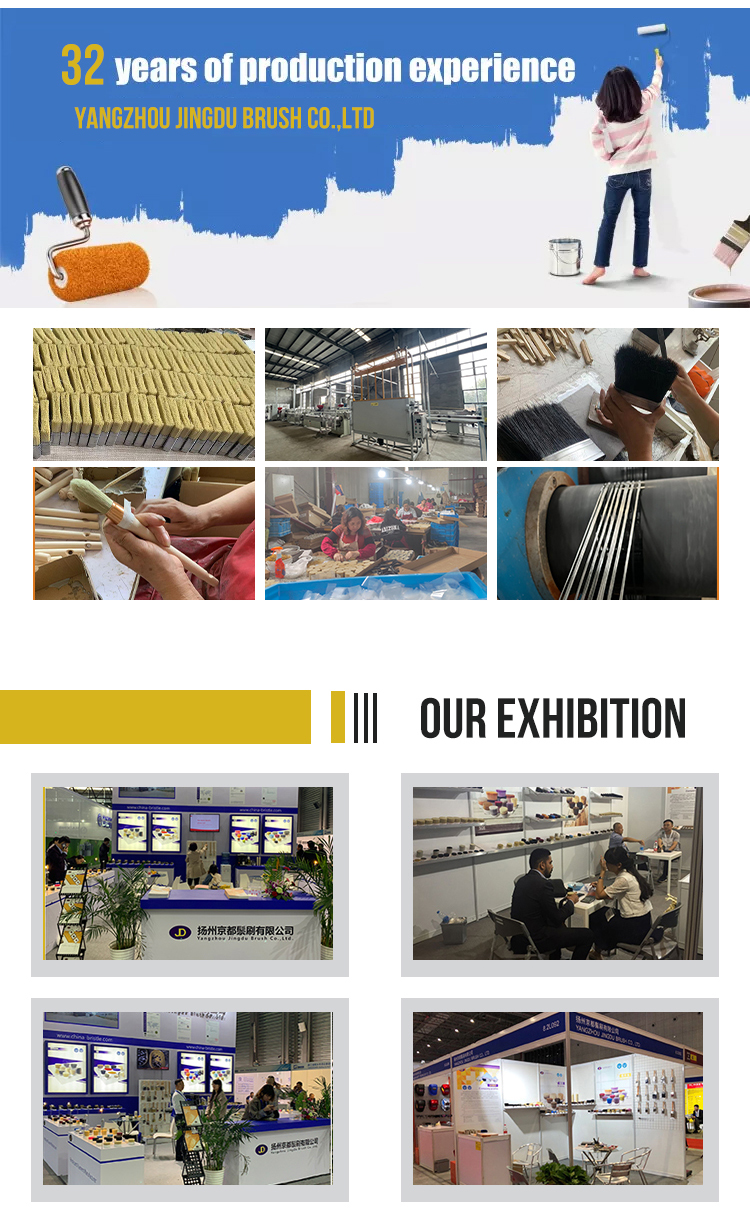
Brushes vary widely depending on the quality of the components used and are designed to apply different paints and varnishes to certain surfaces. The fine filaments may be animal bristles or synthetic, and the quality of the brushes depends greatly on the differences in these materials. The cheap animal bristles used in low-grade brushes are unbleached hog bristles, but the most expensive animal bristles are sable bristles, used for delicate hand-painting. The quality of these synthetic materials varies greatly and can be used in both inexpensive brushes and better quality brushes. The handles are made of wood or plastic; the rounder the brush, the easier it is to manipulate the brush for complex movements.
Most brushes are made in factories. However, more expensive professional-quality brushes can still be manufactured in factories, but can be assembled at least partially by hand assembly methods. Those who need fine brushes for fine oil or watercolor painting can make their own brushes or buy them to order from the experts who produce them. These handmade brushes can be very expensive.
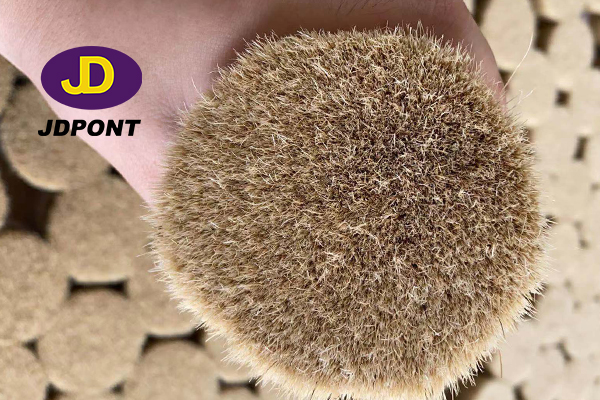
Fine filaments can be animal hair, most commonly long-haired hog bristles, often referred to simply as hog bristles. Other natural animal hairs used in American brushes include squirrel hair, goat hair, cow hair, badger hair, and horse hair. The most expensive animal hair brushes are handmade from sable. The synthetic filaments used in brushes are produced by extrusion (in which a liquid synthetic is pushed through a die and thus formed) and can be acrylic, polyester, nylon or amarone, a very inexpensive petroleum-based synthetic. Different synthetics work better with different kinds of paint, so painters should be aware of filament materials when choosing a brush. Synthetic filaments can have three structures: solid extruded, "x-shaped" or hollow. Solid extruded synthetic filaments last the longest and are the easiest to clean up. x-shaped filaments perform well and are a little cheaper than solid filaments. Hollow filaments wear out quickly and are difficult to clean, but are fairly inexpensive. Consumer grade brushes may be pig bristle or synthetic filament; however, water-based paints (such as latex) perform better when synthetic filament is used.
Handles can be wood or plastic. Different painters prefer the "feel" of a particular handle material; in general, professional painters prefer wooden handles, while "do-it-yourselfers" usually prefer plastic. Epoxy is a two-part glue consisting of an epoxy resin and another part consisting of a catalyst and hardener that is needed to hold the bristles in place inside a metal band called a collar. The collar, the metal band between the handle and the bristles, is always made of metal, either tinned steel or other inexpensive metal. A spacer plug made of wood or cardboard is inserted between the bristles in the brush head (pushed into the collar). This plug provides a well that allows the brush to contain the paint reservoir after it has been dipped into the paint. The paint flows from this well to the tip of the brush.
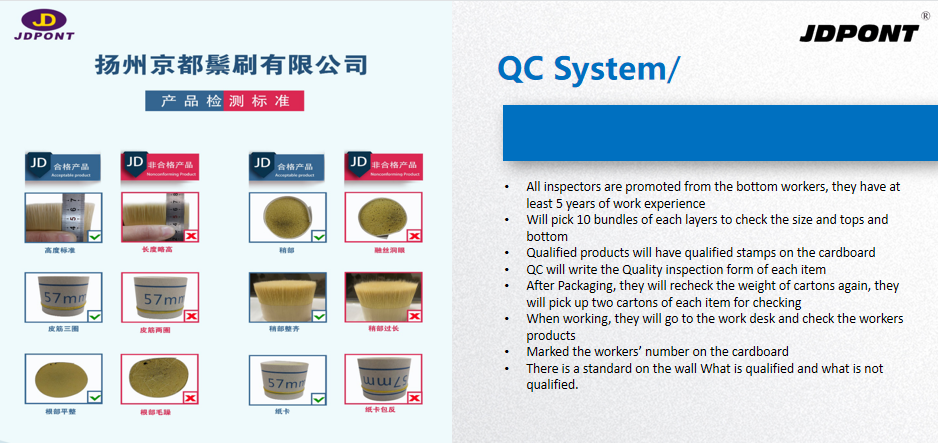
This process will describe the manufacture of consumer grade brushes made from plastic handled hog bristles.
Mixing the bristles
1. First, the bristles (usually imported) are brought into the factory in small bundles that can be held in the hand. Each bundle includes bristles of the same length and taper ratio. However, the bristles must include bristles of different lengths and taper ratios. Bundles must be untied and mixed together. Since each different size and tapered bristles are not bundled together, all bristles are aligned in the same direction on the blender. This machine is a series of belts that move back and forth, folding the bristles and blending them together. This happens when the bristles fall off the belt and onto the top of another set of belts with that set of bristles, and then onto another set of bristles. This is done until the bristles are completely mixed (but still aligned in the same direction). This blending takes about ten minutes.
Select bristles and add
Loop
2. The blended bristles are then placed in the machine and the appropriate amount of bristles (determined by weight) are pinched out to form the size of the bristles in production. The machine then pushes the individual brush bristles into the metal collar (an oval band that helps to secure and hide the bristles from the bristles).
Adding the plug
3. The bristle and collar assembly is placed on a conveyor belt where the device used to further tap the bristles into the collar. When the bristles are pushed halfway into the collar, the pieces are sent to the plugging station. Here, a wooden or cardboard plug, cut to fit the width of the brush being built, is automatically pushed into the "docking end" of the collar (the end that will be attached to the handle). Tap the bristles and plug again to make sure the bristles and plug are tight against the top edge of the collar.
Bristle epoxy
4. By hand, the brushes are pulled off the line and placed on a shelf with the end of the collar up and sent to the gluing station. Here, a worker then injects epoxy into each end of the brush using a machine that injects a drop of epoxy by touching a trigger. This is done one after the other with a manual pump. The brush head is basically finished; it takes about two minutes .
Most brushes are mass produced, but the more expensive professional quality brushes are usually assembled by hand. The brushes used by artists are handmade. Mass-produced brushes are either square or chisel-shaped. Typically, well-defined bristles indicate higher quality professional brushes. Square construction and trim are usually cheaper or used to apply paint over large areas.
Select the bristles, add the ferrule, place the plug, and then epoxy the bristles inside the plug and ferrule. Now set the brush head aside to dry.
Finish the bristles
5. Once the brush head is made and epoxied, the manufacturer must "finish" the brush head. The head is then passed through a series of devices to remove any loose hairs that have escaped from the epoxy. The brush heads are also "angled", which means the ends are slightly feathered or split (dipped into the paint) so they are finer and can absorb the paint more easily (the finer the bristles, the less of the brush the consumer sees) as the paint dries.) The ends can also be tapered. Sanding wheels are used to feather and split the ends, and scissors are usually used to taper them. Now, set the brush to air dry overnight.
Making the handles
6. Handles are made earlier and may come from other manufacturers. Some manufacturers produce their own handles elsewhere in the factory and send them to the brush making department.
Often, consumer-quality brushes have injection-molded plastic handles. To produce such a handle, a mold with two halves is clamped together, and molten plastic is injected into the mold. The liquid plastic quickly hardens and the mold opens. Many handles can be made in a series of interconnected molds. All plastic handles are joined by "long beams" or long, thin pieces of plastic that must be broken to disconnect the handle. The handles do not require finishing.
Attaching the handle
7. After the brush heads have dried, stack them one on top of the other. One brush head at a time is removed and automatically inserted into the plastic molded handle, which is pressed onto the collar. Once inserted, the brush handle is machine nailed or riveted and pressed onto the collar so that the brush head is securely attached to the handle.
Packing
8. The same machine that inserts the handle into the collar also removes each completed brush and automatically packages the brushes individually. However, many brushes come in little or no packaging and are sold in garbage cans or cardboard boxes at the point of sale. Many brushes come in minimal packaging that includes only small cardboard packages no longer than the length of the brush.
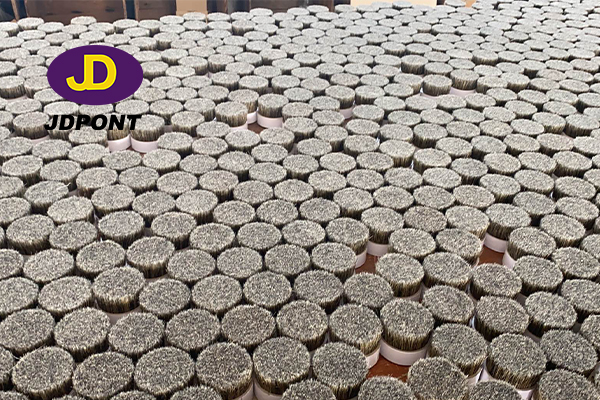
The quality of brushes varies. The quality of brushes depends on the materials used and the method of construction. The quality of brushes is usually clearly marked on the packaging. Even if the consumer quality of the brushes is low, the effectiveness of the material as a brush material is carefully monitored and selected. Poor quality brushes (and very cheap brushes) are produced by using coarse, non-tapered and unfeathered synthetic filaments, as the bristles will show the strokes of each brush. Bristles for consumer grade brushes are usually imported and inspected once they arrive at the factory. The blending process, and especially the finishing process, ensures that sufficient
bristles are sufficiently processed to make quality brushes.
Brush manufacturers employ brush inspectors to control quality by evaluating the product at multiple stages of production. In addition, most U.S. factories encourage employees to visually monitor quality because many of these processes are done in plain sight, rather than inside the "black box" of a machine. Employees are asked to remove parts from the line when they believe the quality is poor.
